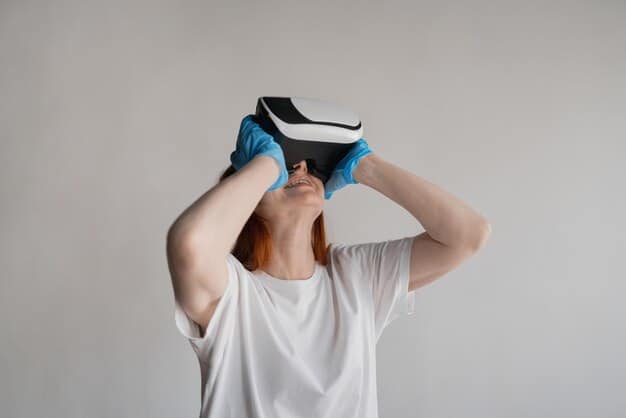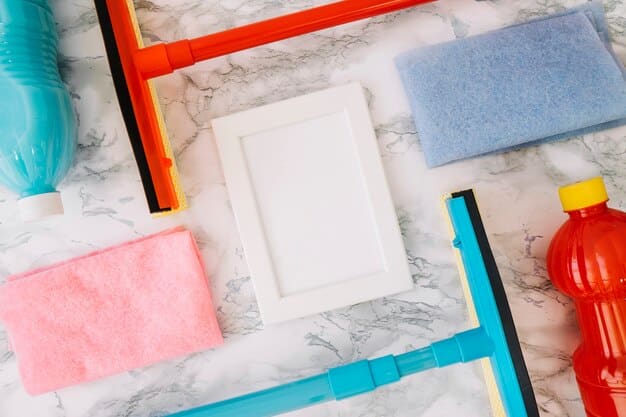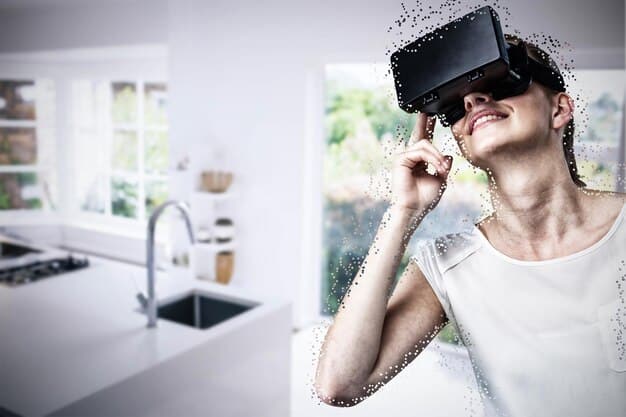VR Hygiene: Tips to Keep Your Headset Clean and Germ-Free

VR hygiene is crucial for maintaining a comfortable and safe virtual reality experience; this article provides simple yet effective tips on how to clean your headset, prevent germ buildup, and ensure long-lasting VR enjoyment.
Virtual reality offers immersive and exciting experiences, but neglecting VR hygiene can quickly turn your headset into a breeding ground for germs. Let’s explore how to keep your VR headset clean and germ-free with these essential tips.
Why is VR Hygiene Important?
Maintaining good VR hygiene is paramount for several reasons. Not only does it contribute to a more pleasant and comfortable user experience, but it also plays a critical role in preventing the spread of germs and bacteria. A clean headset is a happy headset—and a healthier you.
Think about it: VR headsets sit snugly against your face, often during active gaming sessions that can lead to sweat and oil buildup. This creates a perfect environment for microbes to thrive. Regular cleaning can mitigate these issues, keeping your VR experience enjoyable.
Preventing Skin Irritation
One of the primary benefits of VR hygiene is preventing skin irritation. When sweat, oil, and bacteria accumulate on the headset’s surfaces, they can clog pores and cause issues like acne or dermatitis. Keeping the headset clean helps to minimize these risks and keeps your skin healthy.
Reducing Germ Transmission
Sharing VR headsets without proper cleaning can lead to the transmission of germs between users. Viruses and bacteria can live on the headset’s surfaces and easily spread from one person to another. Regular cleaning with appropriate disinfecting solutions can significantly reduce this risk.
- Use Antibacterial Wipes: Regularly wipe down the headset’s faceplate and straps with antibacterial wipes.
- Avoid Sharing During Illness: Refrain from sharing your headset if you or another user is sick to prevent the spread of germs.
- Wash Hands Before Use: Encourage users to wash their hands thoroughly before using the headset.
In conclusion, VR hygiene is not just about keeping your device looking nice; it’s about protecting your skin and preventing the spread of germs. By implementing a few simple practices, you can enjoy a safer and more hygienic VR experience.
Essential Cleaning Supplies for Your VR Headset
To ensure effective VR hygiene, it’s essential to have the right cleaning supplies on hand. Using the appropriate tools and solutions will help you keep your headset clean without damaging it. Here’s a breakdown of essential cleaning supplies:
Having these supplies ready will make it easier to maintain your headset regularly, ensuring a clean and enjoyable VR experience. The right tools not only clean effectively but also protect your device from damage.

Microfiber Cloths
Microfiber cloths are a must-have for cleaning VR headsets. These cloths are soft, non-abrasive, and excellent at removing dust, fingerprints, and smudges without scratching the lenses or other delicate surfaces. Keep a few on hand for regular use.
Isopropyl Alcohol (70% Solution)
A 70% isopropyl alcohol solution is ideal for disinfecting your VR headset. This concentration effectively kills germs and bacteria without being too harsh on the device’s materials. Avoid using higher concentrations, as they can damage the headset.
- Spray Sparingly: Lightly dampen a microfiber cloth with the isopropyl alcohol solution.
- Avoid Direct Contact: Never spray the alcohol directly onto the headset to prevent internal damage.
- Wipe Gently: Gently wipe down the headset’s surfaces, paying attention to areas that come into contact with the skin.
Having the right cleaning supplies is crucial for maintaining VR hygiene. Microfiber cloths, isopropyl alcohol, antibacterial wipes, and a small brush will help you keep your headset clean and germ-free, ensuring a comfortable and safe VR experience.
Step-by-Step Guide to Cleaning Your VR Headset
Cleaning your VR headset doesn’t have to be a daunting task. With a simple step-by-step approach, you can effectively maintain VR hygiene and keep your device in top condition. Here’s a comprehensive guide to help you through the process:
Taking the time to clean your VR headset properly ensures a hygienic and enjoyable VR experience. Follow these steps regularly to keep your device in excellent condition.
Power Down and Disconnect
Before you begin cleaning, always power down your VR headset and disconnect it from any power sources or devices. This prevents any accidental damage during the cleaning process.
Wipe Down Exterior Surfaces
Use a microfiber cloth lightly dampened with a 70% isopropyl alcohol solution to wipe down all exterior surfaces of the headset, including the plastic casing and straps. Pay extra attention to areas that come into contact with your face and hands.
- Focus on the Faceplate: The faceplate is the area that touches your skin, so be thorough in cleaning it.
- Clean the Straps: Straps can absorb sweat and oils, making them a breeding ground for bacteria.
- Avoid Abrasive Cleaners: Do not use harsh or abrasive cleaners that can damage the headset’s materials.
Following these steps will help you maintain excellent VR hygiene, ensuring a clean and comfortable VR experience. Regular cleaning not only keeps germs at bay but also prolongs the lifespan of your VR headset.
Maintaining Lens Clarity: Tips for Cleaning VR Lenses
The lenses of your VR headset are crucial for a clear and immersive experience. Keeping them clean and free from smudges is essential for optimal VR hygiene. Here are some specific tips for cleaning VR lenses without causing damage:
Lens care is a critical aspect of VR hygiene. By using the right techniques and tools, you can ensure that your lenses remain clear and your VR experiences are always sharp and enjoyable.

Use a Lens Cleaning Cloth
Always use a specialized lens cleaning cloth designed for delicate optics. These cloths are made from ultra-fine microfiber and are safe to use on sensitive lenses. Avoid using paper towels or regular cloths, as they can scratch the lens surface.
Blow Away Dust First
Before wiping the lenses, use a can of compressed air or a lens blower to remove any loose dust or debris. This prevents the particles from scratching the lens surface during the cleaning process.
- Apply Gentle Pressure: When wiping the lenses, use a gentle, circular motion.
- Avoid Excessive Moisture: If using a cleaning solution, apply it sparingly to the cloth, not directly to the lens.
- Check for Scratches: Regularly inspect your lenses for any signs of scratches or damage.
Maintaining lens clarity is an integral part of VR hygiene. With these tips, you can keep your VR lenses clean and clear, ensuring an immersive and enjoyable virtual reality experience every time.
Managing Sweat and Moisture During VR Sessions
Sweat and moisture are common during intense VR sessions and can significantly impact VR hygiene. Managing these elements is vital for keeping your headset clean and comfortable. Here are practical tips for managing sweat and moisture:
By taking proactive steps to manage sweat and moisture, you can significantly improve your VR hygiene and ensure a more comfortable and enjoyable VR experience. These practices will also help prolong the life of your headset.
Use a VR Headset Cover or Mask
Consider using a VR headset cover or mask made from moisture-wicking materials. These covers absorb sweat and prevent it from soaking into the headset’s foam padding. They are easy to remove and wash, making them a convenient solution for maintaining cleanliness.
Take Breaks and Allow Ventilation
During longer VR sessions, take periodic breaks to allow your face and the headset to air out. Removing the headset for a few minutes can prevent excessive sweat buildup. Ensure the room is well-ventilated to help reduce moisture levels.
- Wipe Down Regularly: Keep a microfiber cloth handy to wipe down your face and the headset’s faceplate during breaks.
- Use Dehumidifiers: In humid environments, consider using a dehumidifier to reduce moisture in the air.
- Choose Breathable Materials: Opt for headset accessories made from breathable materials to minimize sweat buildup.
Managing sweat and moisture is crucial for VR hygiene. By using headset covers, taking breaks, and ensuring good ventilation, you can keep your VR headset clean and comfortable, even during intense gaming sessions.
Long-Term Storage Solutions for Optimal VR Hygiene
Proper storage is essential for maintaining VR hygiene when your headset is not in use. Storing your headset in a clean and dry environment can prevent the buildup of dust, moisture, and bacteria. Here are some long-term storage solutions to consider:
Implementing these storage solutions will contribute significantly to VR hygiene, ensuring that your headset remains clean, dry, and ready for your next virtual adventure.
Use a Protective Case or Cover
Store your VR headset in a protective case or cover to shield it from dust, sunlight, and other environmental factors. A case not only keeps the headset clean but also protects it from physical damage.
Store in a Cool, Dry Place
Choose a storage location that is cool, dry, and away from direct sunlight. High humidity and extreme temperatures can damage the headset’s components and promote the growth of mold and bacteria.
- Avoid Damp Environments: Ensure the storage area is free from moisture to prevent bacterial growth.
- Clean Before Storing: Always clean your headset before storing it to remove any sweat, oil, or dirt.
- Airtight Containers: For extended storage, consider using an airtight container with silica gel packets to absorb moisture.
Long-term storage solutions play a vital role in VR hygiene. By using protective cases, storing your headset in a cool, dry place, and cleaning it before storing, you can maintain its cleanliness and prolong its lifespan.
| Key Point | Brief Description |
|---|---|
| 🧼 Regular Cleaning | Wipe down your headset with antibacterial wipes after each use. |
| 🧴 Lens Care | Clean lenses with a microfiber cloth and lens cleaning solution. |
| 💦 Sweat Management | Use VR covers and take breaks to minimize sweat buildup. |
| 📦 Proper Storage | Store your headset in a cool, dry place with a protective case. |
FAQ
▼
Ideally, you should clean your VR headset after each use. At a minimum, aim to clean it once a week if you use it frequently to prevent germ buildup.
▼
It’s better to use antibacterial wipes specifically designed for electronics. Regular cleaning wipes might contain harsh chemicals damaging to the headset’s materials.
▼
Anti-fog sprays or wipes designed for lenses can help prevent fogging. Additionally, ensure proper ventilation in the room to reduce humidity levels.
▼
Avoid using bleach, ammonia-based cleaners, and abrasive materials. Stick to a 70% isopropyl alcohol solution and microfiber cloths for safe and effective cleaning.
▼
Immediately power off the headset, disconnect it from any power source, and use a dry microfiber cloth to absorb the moisture. Allow it to air dry completely before using it again.
Conclusion
Maintaining VR hygiene is essential for ensuring a comfortable, safe, and enjoyable virtual reality experience. By following these tips and incorporating regular cleaning practices into your routine, you can keep your headset germ-free and in top condition, ready for your next virtual adventure.





